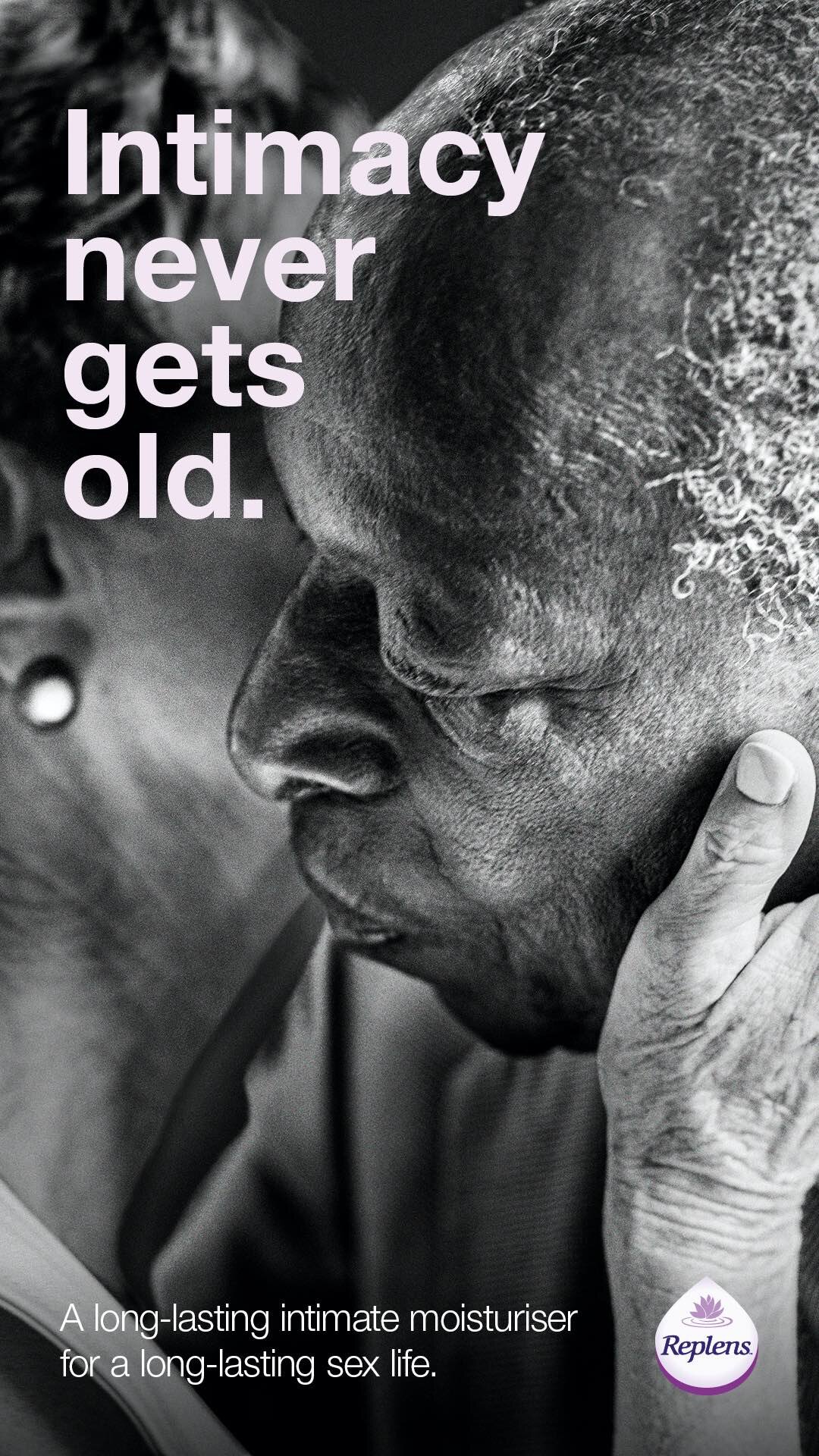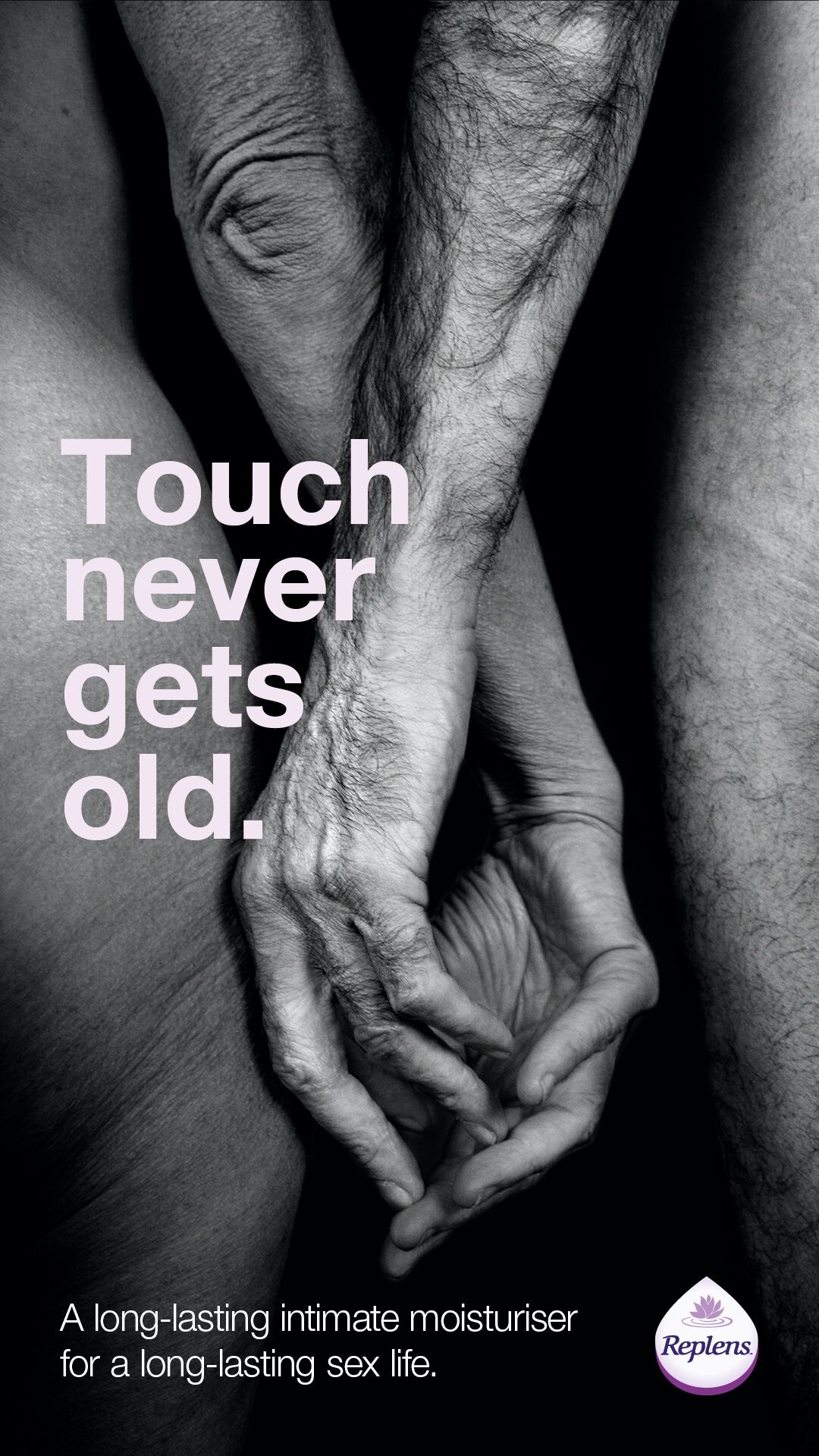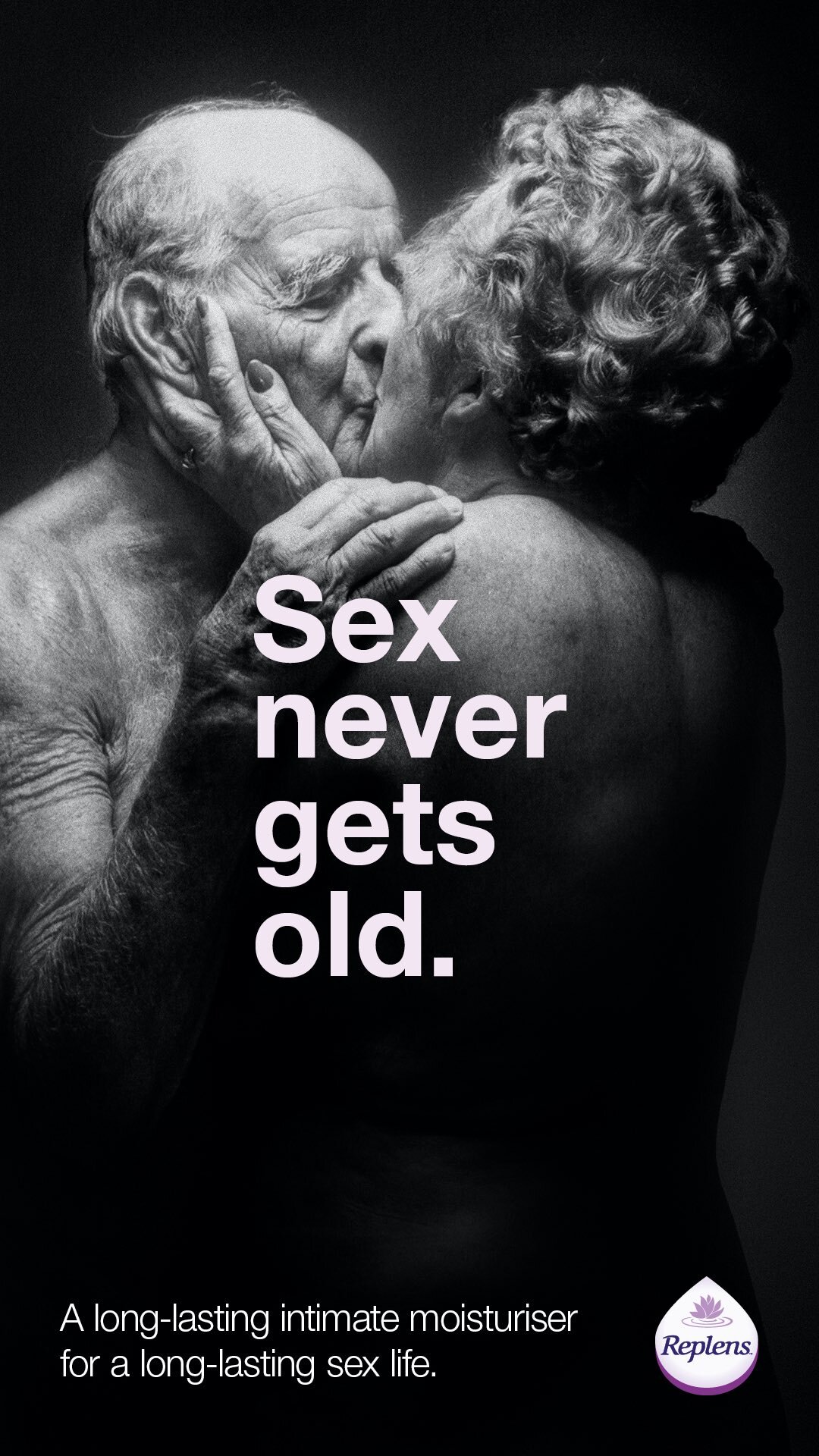Discover an aspirational condition
In Western culture,
we are used to seeing aging as death and decay,
but aging can and should be something to look forward to
Kit Altin, chief strategy officer of the London-based agency The Gate, creator of the brilliant advertising campaign for Replens that portraits the beauty of human connections
This is a beautiful story. Take a courageous marketing team, a vaginal dryness moisturizer, and the chance to win half a million pounds-worth of advertising space in London. The result is a series of black and white posters (see the gallery below) that portray older people sharing intimate moments along the tagline “Sex never gets old.” Replens (the Church and Dwight’s brand) partnered with the advertising agency The Gate. Transports for London promoted its third Diversity in Advertising Award that offered advertising space to ad campaigns that provided an authentic representation of people 55 and over. I didn’t see the posters in London personally, but the images of the stations decorated with these giant-sized campaign or the impossible-to-miss series along an escalator made me feel emotional. It was not just the mix of “finally” and “look at that!” Beyond the pure existence of the images - a conquest in itself - it was the artistic, delicate and human representation of the people portrayed.
I imagine the onlookers, projected at warp speed into an unexpected perspective. On me, the idea of aging took time to grow. I used to credit my ten-year-long experience of employment in an opera house as the source of becoming attuned to the notes. But in retrospect I realize that it did much more than that. In my early twenties, the opera-goers charmed me forever. The old ladies of the aristocratic families with double surname were top of my list. Their perfectly white hair styled with a hint of purple, their slow pace, their velvet flat shoes, their gentle voices when they told me “Thank you dear” while I kept a door opened for them. Far from the parterre, the opera aficionados provided a more diverse but equally fascinating group. The puppet-master was the scalper, a short bald man with a friendly face and a missing tooth in the middle of his smile. He wore a jacket and a coat and carried his German shepherd dogs’ leashes around his neck. Il Piccolo (the small one) was actually the bigger one of the two. The scalper spoke Milanese, had a boundless knowledge of the Austrian domination of the city, and commanded troops of Japanese tourists. There was a lady with thick black-rimmed glasses and short gray hair who often mentioned “my poor Giuseppe,” her late husband who used to attend the opera with her at the gallery. She held me by my arm, when she asked me impromptu questions: “Do they really give bonbons away?”
Behind the scene, it was a show of giants. One night, the Russian cellist Mstislav Rostropovich invited the whole theatre crew to his birthday party. Sitting on a red plastic chair on the black wooden floor backstage, he briefly held my hand and thanked me for my wishes with the most gentle pair of eyes framed by thin golden glasses, a bit démodé. After the doors closed on a dry winter night, I unexpectedly bumped into Carlo Maria Giulini in the courtyard. Still tall and majestic in his eighties, the conductor, in a blue coat and hat, had dropped, by mistake, one of the roses he was carrying. I picked it up for him and he added an “I’m sorry” to his thank-you. For a season, the notes of the orchestra mixed with the words of Thomas Mann. My reading buddies and I were so captured by The Magic Mountain that we imagined spotting the book’s protagonists amongst the audience. Our favorite was the Italian humanist “Mr. Settembrini,” whom we identified in an old man with a brown hat, a brown coat - he carried it on his shoulder like a cloak - and a walking stick. After descending the stairs, he used to stand on the marble floor like a modern Roi Soleil.
Back to present time, Michael Benson, the marketing director of Replens and Kit Altin, the chief strategy officer of the London-based agency The Gate walked me behind the scene of the making of this campaign and explained the “secret” of its transformational power.
When it comes to advertising, clients tend to “play it safe.” What has tipped the scale in this case?
(Michael) Our brand helps women to deal with a natural condition that comes with age. We wanted to normalize the conversation around this issue and make a statement for the brand. We embrace the fact that we can make a difference in people’s lives and we invite people to reconsider their view on their love lives. What stands out in this campaign is the tremendous balance between care and boldness.
Images play a part in the spreading of ageism. How did you fine-tune the representation of old age? Was this a challenge?
(Michael) We believe that people can relate better with an honest representation. We had a chance to open up conversations and we decided to give our contribution to removing the embarrassment and the stigma. We had tremendously positive feedback from the press and social media. Because this is a sensitive and caring way to address a natural condition, people can relate with it, no matter their age. We helped to re-assess the emotion regarding getting older and living a fulfilling life.
This campaign tackles three prejudices in one go: diversity, aging, and the sexual life of older adults. Which one did you identify first? How did the other ones come about?
(Michael) They all came about at the same time. It was a great challenge. We felt this brand could enter a different view on how we are dealing with a natural condition. We decided to take a stand.
What we do not see has an impact on our idea of aging. Winning £ 500,000-worth of advertising space in London is a huge opportunity. How did the public react to your campaign?
(Michael) As I said, we had tremendously positive feedback from the press and social media. They recognized a sensitive and caring way to address a natural condition.
(Kit) The feedback was fantastic. People commented that it is inspiring to see intimacy between older adults portrayed so candidly and beautifully.
What was the genesis of this campaign?
(Kit) From research, we discovered that many people are engaged and have interest in sex in later life - yet this is rarely, if ever, represented in culture, especially in advertising. This tension was the insight that lead to the campaign. There is a real societal prejudice when it comes to the sexual life of older adults that we wanted to take on. We decided to go beyond the stereotypes and represent real intimate connections between people in mid life and beyond.
Getty Images launched the Disrupt Ageism Collection. The majority of these pictures present old people as young ones, replicating the “successful aging” narrative, and failing to address the depth of the transformational process of aging. What is your take?
(Kit) Finding the images for our campaign was incredibly difficult and really reflects the cultural problem. First, there are very few images of people over 55 that are not horribly clichéd. There’s almost nothing at all showing older people living fully. Secondly, we had to shoot images in the middle of the pandemic. The campaign is a result of sourced and shot pictures.
Our images were chosen for their ability to show intimacy in an authentic and beautiful way, and to balance a radical candour with delicacy and sensitivity. We really used an artistic lens to make our choices. These are not typical advertising images, and that is why people react so positively. We show people something they didn’t consider before, but something that feels really natural at the same time and this helped us to by-pass learned thinking about age. We focused on positive, celebratory elements and provoked an emotional reaction to the pictures. And once you’ve done that, you’ve captured your audience and you’re already getting them to think differently.
Should we aim for regulations that promote age-diversity where the images that shape our world are created?
(Kit) We need to change the way people think. Business and brands make it already mandatory to have inclusive representation for ethnicity, and rightly so, but we haven’t seen the same requests for age diversity, so I think we should begin to consider this option where appropriate, just to get things moving. It’s not that people are against it, it simply doesn’t occur to them. I hope campaigns like ours play a role in creating that awareness and hopefully a natural wave of change as people realise it’s the right thing to do.
How has researching and exploring aging changed your perspective on aging?
(Kit) I have never been scared of getting older; it is a privilege. But working on this campaign did shift my perspective on aging a bit, I think, from “inevitable” to “aspirational.” Because I don’t think I have ever seen a campaign that has presented aging in such an aspirational way as we have. And it’s so beautiful! I’ve seen these images a hundred times and even now when I look at them I can feel the profound emotion and the beauty of the human connection, which is only made deeper and more magical with time. There is a profound “rightness” about these images. When I see them I think, “YES - that’s what’s been missing all this time!” In Western culture in particular, we are used to seeing ageing as death and decay, but aging can and should be something to aspire to, to look forward to. If I find myself at 60 or 80 with a fraction of the energy, passion and joy of the people in our campaign, I’ll have won the game of life.




